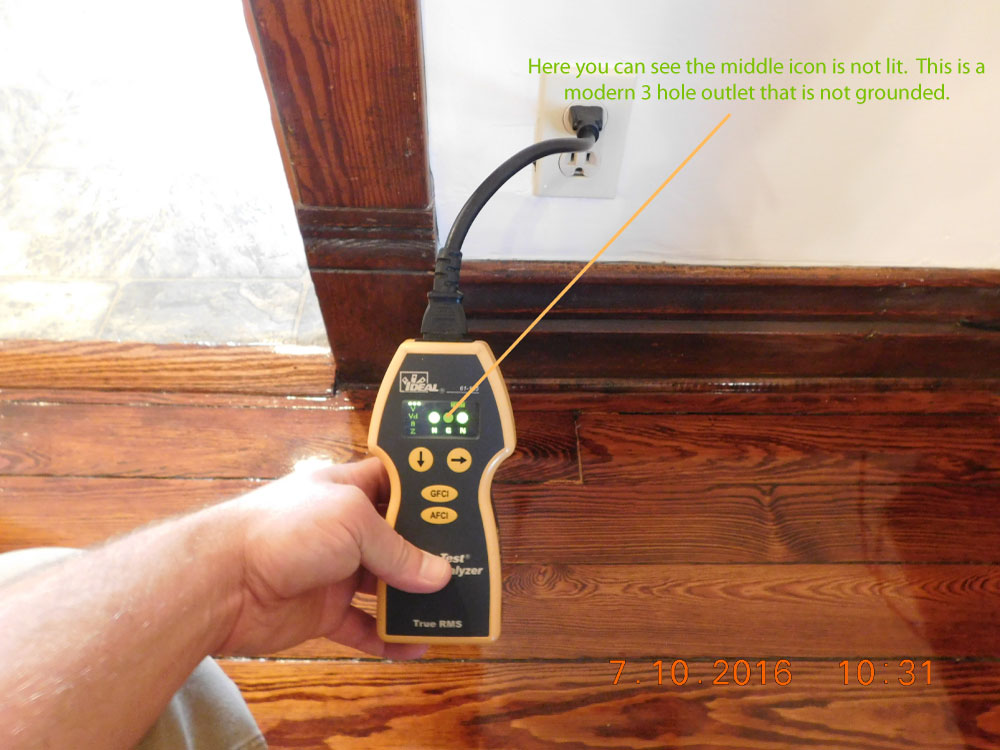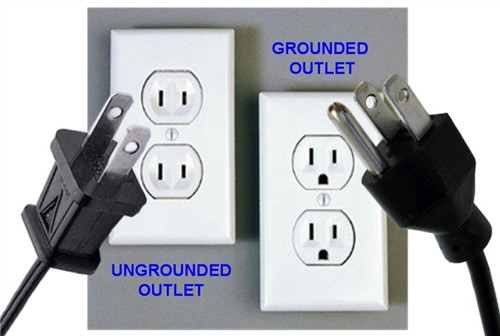Are Ungrounded Electrical Outlets Safe?
It never fails. At least once a week I inspect a house that has an ungrounded electrical system. These are older homes with receptacles (or outlets, as everyone in my neck of the woods calls them) that only have two slots, and are missing the ‘3rd hole.’ That hole is for the ground conductor of the circuit. The grounding conductor wasn’t introduced until ~1962 in Louisville, KY. So if you live in an older home, that hasn’t been upgraded to modern electrical safety standards, chances are your system is ungrounded too – or at least part of it is. This could be true even if you have modern 3-hole outlets installed. I get a lot of deer-in-headlights looks when I start to talk about this stuff at my home inspections, so let me break things down for you here, and explain what all this means.
HOW TO TELL IF YOU HAVE UNGROUNDED OUTLETS
Most of the time, you can simply look at your outlets and see if you still have the old ungrounded style or not. If you only see two vertical slots, they are ungrounded. However, I see lots of older houses where folks will replace their outlets with new (modern, 3-hole) outlets to make it easier to plug grounded cords in. Of course, this doesn’t make things “grounded,” you simply lose the frustration of having to use one of those cheater adapters that have the ground pin missing. If you are unsure if your receptacles are grounded, you can pick up a cheap outlet tester and it will tell you if you have a ground connected at the outlet. My receptacle tester that I use during home inspections is way more sophisticated as a circuit analyzer, but in this case essentially reports the same info: is there a ground present at the outlet. You can see an example of this in the picture below. I’m plugged into a 3-hole outlet in a 90 yr old house, but the ground icon (center light) is not lit up. This is an ungrounded 3 hole outlet.

UNGROUNDED ELECTRICAL OUTLETS CAN BE A HAZARD
First, let’s briefly run through how electricity in your home works; more specifically, how the outlets work when something is plugged into them. The most important thing to remember is that electricity flows in a circuit, and it’s always trying to get back to the source. The electrons flow from the hot side of an outlet, through the device that is plugged into it (toaster/vacuum/hairdryer/etc), and back through the neutral wire to the panel (or the source.) The device you plug into the outlet completes the circuit between the hot and the neutral wires, and electricity flows through the device to run a motor, heat some coils, or whatever is needed. That is a basic 120v circuit. Pretty simple. Notice I did not bring up the use of a ground wire at all…
The hot wire is connected to the electric panel via a circuit breaker (or fuse, if your system is really old). The breaker is in place to trip (kill the power) if it senses the current flow is too high in the circuit. (This is why it’s important that your breakers be sized correctly for the wire it’s protecting.) If the breaker sees an abnormal amount of current flowing through it, it trips and shuts down the power. When a breaker trips it is known as a fault. The fault must be found and “cleared” before things can return to normal, and you can turn the power back on.
As you can see from the above example, a ground wire is not needed for a 120v circuit to function. In fact, there are lots of things you plug into your electrical system that doesn’t use the 3rd pin at all. Lamps, cell phone chargers, and toasters only have two prongs on their cords. However, there are lots of other items in your home that do utilize the ground as a safety measure. Things like refrigerators, washing machines, computers, and TVs have grounded cords. The grounded cords typically show up on items that have a metal case or have sensitive electronics inside them.
Having a fully grounded electrical system is all about safety. It’s a safety measure put in place for you, your house, and your stuff that is plugged into/connected to your house. In fact, the “ground” we are talking about is technically known as an equipment ground. There are system grounds (power company side of things), and equipment grounds (your house side of things). Everyone around here (and I would imagine many other places) just calls it a ground, so we’ll stick with that.
Grounding is in place to protect us from faults (bad things within an electrical circuit) and damage from lightning strikes. Faults just happen. Electrical motors go bad, wires break, etc. Lightning strikes also get filed under “it happens.” According to NOAA, there are 25,000,000 cloud-to-ground lightning strikes every year. Let’s break down some examples of why equipment grounding and grounded outlets are important to you and the safety of your family.
While not perfect, this video does a good job of explaining the history and progression of the electrical system in homes in the U.S.
PROBLEMS WITH UNGROUNDED OUTLETS
The ground wire in an electric system is in place to send rogue current safely back to the electric panel (or the source). In the event of a problem within the circuit, the ground wire provides a path for the current to safely make it back to the panel to trip the breaker or blow the fuse.
The following are some examples of what can happen when dealing with an ungrounded electrical system – especially ungrounded outlets. What you want to keep in mind is that these things occur when bad things happen. Grounding is not needed when life is good and things are rolling on as they should be. Think of it like an airbag in your car. You can drive all day every day and never need your airbag. It’s when bad things (like a wreck) happen that you sure are happy to have that safety device.
ELECTRICAL FAULTS
When something goes wrong in an electrical circuit, we call that a fault. We now use grounded circuits to help protect us from these faults.
SURGE PROTECTORS
Surge protectors when used in an ungrounded house are nothing more than really cool-looking extension cords. They can not protect your equipment from surges without the ground wire. That is how they work- they use the ground wire to safely remove the spike or surge in voltage. The warranty on your stuff they brag about when using their product goes out the window too when used on an ungrounded outlet.
lts. Example: Let’s say we have a refrigerator plugged into an ungrounded outlet. If a wire inside the unit were to touch the metal case of the fridge- the case is now conducting the current. It’s very possible the resistance will be low enough that the breaker will not trip. You come along to grab a cold beer after a hard day of crawling through attics and crawlspaces, you could get electrocuted. No one should have to choose from getting shocked, or getting a beer, btw.
LIGHTNING STRIKES
1 out of every 200 houses will be struck by lightning. This is according to the National Lightning Safety Institute. Lightning is an extremely powerful, high-frequency blast of DC voltage, which is capable of devastating damage when you get hit by a direct strike. However, you do not have to suffer a direct hit to have bad things happen. When lightning hits the ground it pushes electrons in all directions. If your house happens to be close enough to this strike, the voltage can jump to the building. This is known as side flash. Now that stray voltage is in the building (on the plumbing pipes, in the wires, etc.) We ground the house to help this voltage get to where it wants to go….the earth (or ground). In other words, we connect all the conductive materials in the house and terminate them to a single point- the ground rod near the electrical panel, or other means (like a water pipe that runs through the yard.)
SIDE FLASH – ELECTROCUTION
Side flash is what happens when an indirect lightning strike happens and the stray voltage from the strike jumps to conductive things inside the house (like plumbing parts and wiring). If you happen to be standing close to one of these things like an ungrounded outlet, or a steel post in your basement, it could jump over to you and cause you to become electrocuted.
SIDE FLASH – HOUSE FIRE
Take the same concept as above with side flash, but you place a combustible material in the mix and you could have a house fire. Even worse, you get electrocuted, you burst into flames, and it sets your house on fire. Hey…it could happen.
MIKE HOLT
Watch this video for a couple of minutes. Mike does a great job of explaining things equipment grounding in a building.
Grounding can save your bacon if things go south one day. There is a good reason the process has been required in homes since 1962. I know some of this sounds scary to folks, and while I don’t want to promote fear, I do like to promote education and respect for something that can kill you in the blink of an eye. But all is not lost. When it comes to getting this issue taken care of, there are options. In future posts, I’ll break down those for you, and explain how all that works. Check back soon…




Ben Hendricks
Hi, I’m Ben, and I inspect houses. I grew up with a hammer in my hand, and have been a professional home inspector for 15 years. My blog is here for info about home inspections around the Louisville, Kentucky area, and just about anything construction-related.